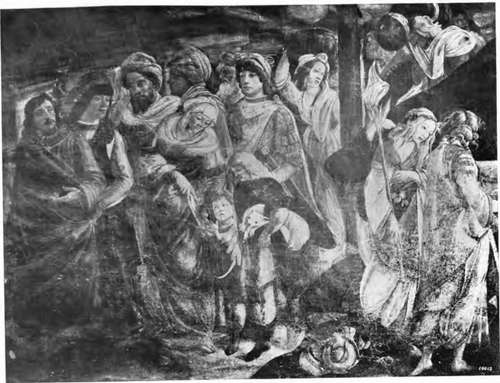Fresco Painting. Part 5
Description
This section is from the book "Mural Painting", by F. Hamilton Jackson. Also available from Amazon: Mural Painting: -1904.
Fresco Painting. Part 5
Fresco secco differs from buon fresco in that it is not painted upon wet plaster. The same colours are used, and it is claimed by some that it is as durable as real fresco, and will bear being washed quite as well The plastering having been completed, and lime and sand only used for the last coat, the whole is allowed to dry thoroughly. It is then rubbed with pumice stone, and the evening before the painting is to be commenced the surface must be well wetted with water in which a little lime has been mixed. The next morniftg the surface is again moistened and the cartoons fastened up so that the outline may be pounced. The colours are mixed with water only as in buon fresco. If the wall becomes too dry it is moistened by sprinkling, or with a fine syringe. The process is ancient and is described by Theophilus. With Cennini the word " secco " generally means tempera. Professor Church says the fixation of the pigments is less complete. Peter of S. Audemar gives the medium for " secco " as either egg or gum, confusing it with tempera as Cennini does.

THE HISTORY OF MOSES.
Portion of fresco by Botticelli in the Sistine Chapel, Rome.
The most modern opinion is that up to the time of Giotto tempera only was used, but that his practice was to begin with fresco, finishing and adding small details in " secco," and that true fresco did not become common until the end of the fourteenth century.
The most accessible modern frescoes are (for the Englishman) Sir E. J. Poynter's Martyrdom of S. Stephen in S. Stephen's Church, Dulwich; Mr. Watts's fresco of the Lawgivers in the hall at Lincoln's Inn; Mr. Dyce's figures of Apostles, etc., on the east wall of All Saints', Margaret Street; Mr. Armitage's frescoes in the church of S. John, Duncan Terrace, Islington; and those by various artists in the corridors of the Houses of Parliament and in the House of Lords. A very successful series was painted by Mr. Dyce in the King's Robing-Room—subjects from the Morte <$}Arthur, illustrating the knightly virtues of "Courtesy" (Sir Tristram harping to La Belle Isoude), " Religion " (the vision of Sir Galahad and his company), " Generosity " (King Arthur unhorsed spared by Sir Lancelot), "Hospitality" (the admission of Sir Tristram to the Round Table), and " Mercy " (Sir Gawaine sworn to be merciful and never to be against ladies). They are in very fair preservation except for efflorescence and scaling here and there, mostly in the less successful subjects fortunately. The most successful are the "Religion" over the fireplace, an excellent piece of design and painting, and the "Hospitality" opposite the windows. The skies throughout are very luminous, and the restriction in the number of possible colours scarcely felt at all, the absence of brilliant reds and yellows being rather an advantage than otherwise, and the blues have been lowered very scientifically. A few of the heads have become black in the endeavour to give more relief by modelling, especially in "Courtesy" and "Mercy." The darks of the hair in the background figures in "Hospitality" might be lighter with advantage, thus giving a slight prominence to the foreground figures in accordance with the difference in size.
Sir Edward Poynter's fresco of S. Stephen is nearly in a perfect state. The frescoes at All Saints', Margaret Street, were cleaned and retouched by Mr. Armitage a good many years ago.
Continue to:
- prev: Fresco Painting. Part 4
- Table of Contents
- next: Tempera
